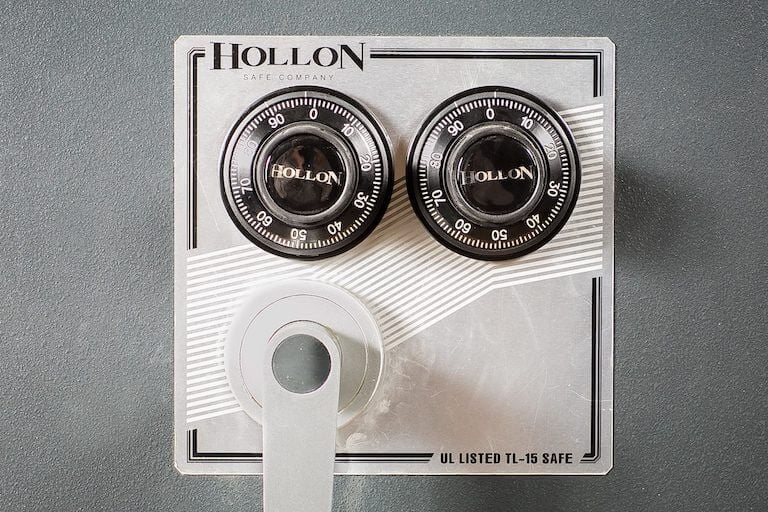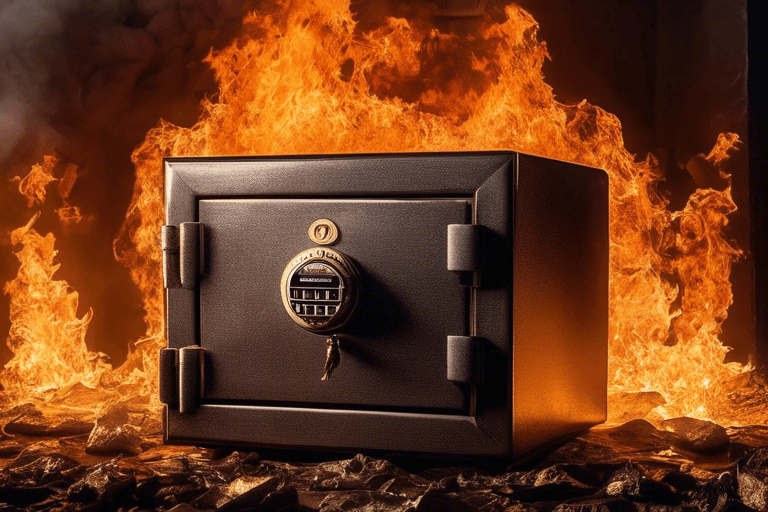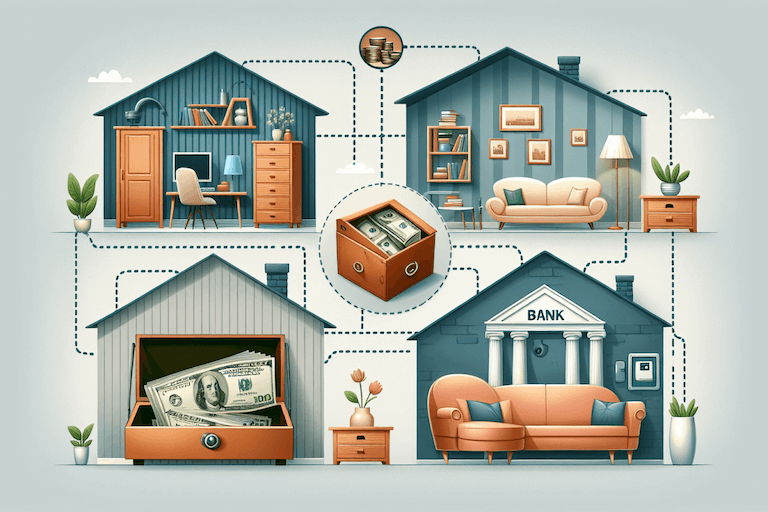
Choosing the Best Safe Lock: The Different Types of Locks Available
When it comes to securing your valuable possessions, another decision to make when choosing a home safe is what type of lock to use.
Deciding on the most suitable lock type is just as important as choosing the right size of safe and whether or not it's fire rated.
The lock is the primary line of defense against unauthorized access, ensuring that your belongings remain protected. Choosing the right safe lock not only provides security but also offers convenience and peace of mind.
Understanding the different types of safe locks available and their pros and cons will help you make an informed decision that aligns with your specific needs. Let's walk through the different types available and the factors to consider when deciding which one is right for you.
In this guide:
> Mechanical Locks: Classic Reliability
> Electronic Locks: Convenience and Security Combined
> Biometric Locks: Cutting-Edge Technology for Quick Access
> Key Locks: Simple and Cost-Effective
> Factors to Consider When Choosing a Safe Lock
Mechanical Locks: Classic Reliability
Mechanical locks have stood the test of time and are known for their reliability. These locks operate using a combination dial, which requires the user to turn the dial to specific numbers to unlock the safe.
Mechanical locks offer a classic and elegant look, making them suitable for both residential safes and commercial safes.
How Mechanical Locks Work
Mechanical locks function through a series of interconnected wheels or discs that align to allow the lock to be opened.
The user needs to turn the dial clockwise to a predetermined number, then counterclockwise to another number, and finally return clockwise to the last number in the combination sequence.
Once the correct combination is entered, the lock's bolt mechanism is released, allowing the safe to be opened.
Advantages of Mechanical Locks
Mechanical locks have several advantages that make them a popular choice:
Reliability: Mechanical locks have a long-standing reputation for their reliability and durability. They are less prone to malfunctions and are not affected by power outages or electronic failures.
Long Lifespan: Mechanical locks are known for their longevity and can last for decades with minimal maintenance.
Classic Look: The timeless design of mechanical locks adds a touch of elegance to any safe. They are particularly suitable for traditional or vintage-style safes.
Disadvantages of Mechanical Locks
While mechanical locks have their advantages, they also come with a few drawbacks:
Slower Access: Unlocking a mechanical lock can be a slower process compared to electronic or biometric locks. It requires precise dialing and can take longer to open, especially if the combination is complex.
Limited Combination Variations: Mechanical locks typically have a limited number of possible combinations compared to electronic locks. This makes them slightly more vulnerable to brute force attacks.
Best Mechanical Locks on the Market
When it comes to mechanical locks, two brands stand out for their quality and reliability:
-
Sargent and Greenleaf: Sargent and Greenleaf is a reputable brand known for manufacturing high-quality mechanical locks. Their 6741 and 6730 models are popular choices due to their long lifespan and excellent security features.
-
La Gard: La Gard is another trusted brand in the industry, offering a rangeof mechanical locks suitable for various applications. Their 3330 and 3331 models are widely recognized for their reliability and security.
Electronic Locks: Convenience and Security Combined
Electronic locks have come a long way and gained popularity in recent years due to their convenience and advanced security features.
These locks use electronic components, such as keypads, to allow access to the safe.
Electronic locks offer quick and easy access, customizable codes, and additional security features not found in mechanical locks.
How Electronic Locks Work
Electronic locks utilize a keypad that requires the user to enter a unique code to unlock the safe. The code can be a combination of numbers, letters, or a combination of both.
Some electronic locks also offer the option of using biometric features, such as fingerprint recognition, for added security (we'll talk about biometric locks below).
Advantages of Electronic Locks
Electronic locks offer numerous advantages that make them a popular choice:
Convenience: Electronic locks provide quick and easy access to your safe. With just a few simple keystrokes, you can open your safe without the need for keys or dialing a combination.
High Security: Electronic locks are designed with advanced security features, such as anti-tamper mechanisms and incorrect code lockouts. They offer a high level of protection against unauthorized access.
Customizable Codes: Electronic locks allow you to set and change your own unique code, providing flexibility and convenience. You can also program multiple codes, making it ideal for shared access or temporary users.
Additional Security Features: Some electronic locks come with additional security features, such as time delay functions, audit trails, and duress codes. These features enhance the overall security of your safe.
Disadvantages of Electronic Locks
While electronic locks offer many benefits, they also have a few disadvantages:
Battery Dependence: Electronic locks require a power source, usually in the form of batteries. It is essential to regularly monitor and replace the batteries to ensure uninterrupted functionality, though the batteries can typically be replaced from outside the safe.
Vulnerability to Electric Failures: In the event of a power outage or electrical failure, electronic locks may become temporarily inaccessible. However, most electronic locks have backup power options or emergency override keys to address this issue.
Top-Rated Electronic Locks
When choosing an electronic lock, it is crucial to opt for a trusted brand known for its quality and reliability. Here are two top-rated electronic lock brands:
- SecuRam: SecuRam are widely recognized for their high-quality electronic safe locks. Their ScanLogic and ProLogic series offer advanced features and robust security.
-
La Gard: La Gard also offers a range of electronic safe locks known for their durability and security. Their AuditGard and BasicGard models are popular choices among safe owners.
Biometric Locks: Cutting-Edge Technology for Quick Access
Biometric locks represent the latest innovation in safe lock technology. These locks use fingerprint recognition to grant access to the safe, providing quick and convenient entry.
Biometric locks offer a high level of security and eliminate the need for memorizing codes or carrying keys.
How Biometric Locks Work
Biometric locks use fingerprint scanning technology to identify and authenticate the user.
The lock's sensor captures a unique fingerprint image, which is then compared to pre-registered fingerprints stored in the lock's database. If the fingerprint matches, the lock mechanism is released, allowing the safe to be opened.
Advantages of Biometric Locks
Biometric locks offer several advantages that make them an attractive option:
Quick and Convenient Access: With biometric locks, you can access your safe with a simple swipe of your finger. This allows for quick and hassle-free entry, especially in emergency situations.
High Level of Security: Biometric locks provide a high level of security by using unique biometric data. Fingerprint recognition is difficult to replicate, making it highly secure against unauthorized access.
Multiple User Access: Many biometric locks allow you to register multiple fingerprints, allowing authorized individuals to access the safe. This feature is especially useful in commercial settings or shared safes.
Advanced Features: Some biometric locks offer additional features such as time delay options, audit trails, and remote access control. These features enhance the overall security and functionality of the lock.
Disadvantages of Biometric Locks
Despite their advantages, biometric locks also have a few limitations:
Environmental Factors: Biometric locks can be affected by environmental factors such as dirt, moisture, or extreme temperatures. It is essential to keep the lock's sensor clean and free from any obstructions for optimal performance.
False Acceptance and Rejection Rates: Biometric locks can occasionally experience false acceptance or rejection rates. Improper finger placement or changes in the finger's condition, such as cuts or wetness, can lead to authentication issues.
Worth the Extra Investment?
Biometric locks are generally more expensive than mechanical or electronic locks due to their advanced technology. Whether or not they are worth the extra investment depends on your specific needs and preferences.
If quick and convenient access is a priority, and you value the latest technology and enhanced security, a biometric lock may be worth considering.
Key Locks: Simple and Cost-Effective
Key locks offer a simple and cost-effective solution for securing safes. These locks operate using a physical key that is inserted into the lock mechanism to grant access.
Key locks are widely used in residential and commercial safes, offering a traditional and straightforward security solution.
How Key Locks Work
Key locks operate by inserting a specific key into the lock's keyway. The key's unique pattern aligns with the lock's mechanism, allowing it to be turned and unlocking the safe.
Key locks are typically made of durable materials to prevent unauthorized duplication.
Advantages of Key Locks
Key locks have several advantages that make them a popular choice:
Cost-Effective: Key locks are generally more affordable compared to electronic or biometric locks. They provide a reliable security solution without the need for advanced technology.
Easy to Use: Key locks are straightforward to use and require minimal effort. Inserting the key and turning it unlocks the safe, providing quick and convenient access.
No Need for Memorizing Codes: Unlike combination locks or electronic locks, key locks do not require the user to memorize codes. As long as you have the key, you can easily open the safe.
Disadvantages of Key Locks
Despite their advantages, key locks have a few limitations:
Risk of Key Loss or Theft: Key locks are vulnerable to key loss or theft. If the key falls into the wrong hands, unauthorized access to the safe becomes a possibility. It is essential to keep the key in a secure location and consider duplicating it for backup purposes.
Limited User Identification: Key locks do not provide individual user identification. Once the key is in possession, anyone with access to the key can open the safe, making it challenging to track access history.
Factors to Consider When Choosing a Safe Lock
When selecting a safe lock, it is essential to consider several factors to ensure it meets your specific needs.
By evaluating these factors, you can make an informed decision that aligns with your security requirements, budget, and ease of use. The key factors to consider include:
Security Needs and Level of Protection
The primary purpose of a safe lock is to provide security. Assess your security needs and the level of protection required for the items you plan to store in the safe.
Consider factors such as the value of the items, the potential risks involved, and the level of security you are comfortable with.
For high-security applications or storing extremely valuable items, it may be advisable to invest in more sophisticated lock options, such as electronic or biometric locks. If the safe will primarily contain low-value items or serve as a deterrent against casual theft, a mechanical or key lock may be sufficient.
Budget and Affordability
Budget considerations play a significant role in the selection of a safe lock. Different types of locks vary in price, with electronic and biometric locks generally being more expensive compared to mechanical or key locks.
Determine your budget and allocate funds accordingly based on the level of security and convenience you require.
It is important to strike a balance between cost and quality when selecting a safe lock. While affordability is a consideration, compromising on security features or reliability may have long-term consequences.
Consider the lock's lifespan and warranty coverage to ensure you are making a worthwhile investment.
Ease of Use and Convenience
Consider the ease of use and convenience offered by different types of locks.
Mechanical locks may require precise dialing of the combination, while electronic locks offer the convenience of quick access through a keypad or biometric feature.
Evaluate your personal preferences and the intended users of the safe to determine which lock type suits your needs best.
If multiple users will have access to the safe, consider locks that allow for the programming of multiple codes or the use of biometric recognition for individual identification.
Maintenance and Service Requirements
Different types of locks have varying maintenance and service requirements.
Mechanical locks generally require minimal maintenance, while electronic locks may require occasional battery replacement. Biometric locks may require regular cleaning of the sensor area to ensure accurate fingerprint recognition.
Consider the practicality of maintaining the lock and factor in any additional costs associated with maintenance or service. Understanding the lock's maintenance requirements will help ensure its longevity and reliable performance.
Warranty and After-Sales Support
When choosing a safe lock, it is essential to consider the warranty and after-sales support provided by the manufacturer or dealer. A comprehensive warranty provides peace of mind, knowing that your investment is protected against defects or malfunctions.
Review the terms and coverage of the warranty, including the duration, specific components covered, and any conditions or limitations. Ensure that the warranty aligns with your expectations and provides adequate protection for the lock's lifespan.
Safe Locks and Extreme Situations
Safe locks may face specific challenges in extreme situations, such as harsh climates or electromagnetic pulse (EMP) attacks. Understanding the performance of the lock under these circumstances is crucial for ensuring the security of your valuables.
Safe Locks and Extreme Climate Conditions
In harsh climates with high humidity or extreme temperature variations, the performance of the lock may be affected. Mechanical locks may be more resilient in such conditions, as they are less susceptible to electronic malfunctions or damage caused by moisture.
Electronic locks, on the other hand, may require additional protection or regular inspection to ensure their functionality in extreme climates. Consider the environmental conditions of your location and opt for a lock that is suitable for those conditions.
Safe Locks and EMP Attacks
Electromagnetic pulse (EMP) attacks can disrupt electronic systems and potentially affect electronic safe locks. While the likelihood of an EMP attack is relatively low, it is essential to consider the potential impact on your safe lock's functionality.
Some electronic locks are designed to withstand EMP attacks by incorporating protective measures, such as shielding or surge protection.
If you are concerned about the vulnerability of electronic locks to EMP attacks, consult with a safe expert or locksmith for guidance on suitable options.
Conclusion: Choosing the Best Safe Lock for Your Needs
Selecting the best safe lock for your needs requires careful consideration of various factors, including security requirements, budget, convenience, and maintenance.
Mechanical locks offer reliability and a classic look, while electronic locks provide convenience and advanced security features. Biometric locks offer quick access through fingerprint recognition, while key locks offer simplicity and cost-effectiveness.
By understanding the advantages and disadvantages of each type of lock, you can make an informed decision that aligns with your specific needs.
Remember to consider the warranty and after-sales support provided by the manufacturer or dealer to ensure a reliable and protected investment.
Ultimately, the best safe lock is one that provides the level of security, convenience, and peace of mind you desire. With the right safe lock, you can ensure the safety and protection of your valuable possessions for years to come.
Frequently Asked Questions
Can I Change the Lock on My Safe?
In most cases, the lock on a safe can be replaced. However, it is strongly recommended to have an experienced locksmith or safe technician perform the replacement to prevent any damage to the safe. Additionally, attempting to replace the lock yourself may void the warranty on the safe.
Should I Get a Dual Lock?
Dual locks, which incorporate both a keypad and a key, are not recommended. They are typically not certified by independent product safety organizations like Underwriters Laboratories (UL), and they often have reliability issues. Moreover, dual locks may require drilling a new template during repairs, which can be costly.
What if I Forget My Combination?
If you forget the combination to your safe with a mechanical lock, consult a professional locksmith or safe technician. They can assist you in recovering the forgotten combination. It is important to ensure that you register your warranty to facilitate easy access to the safe if the combination is forgotten.






